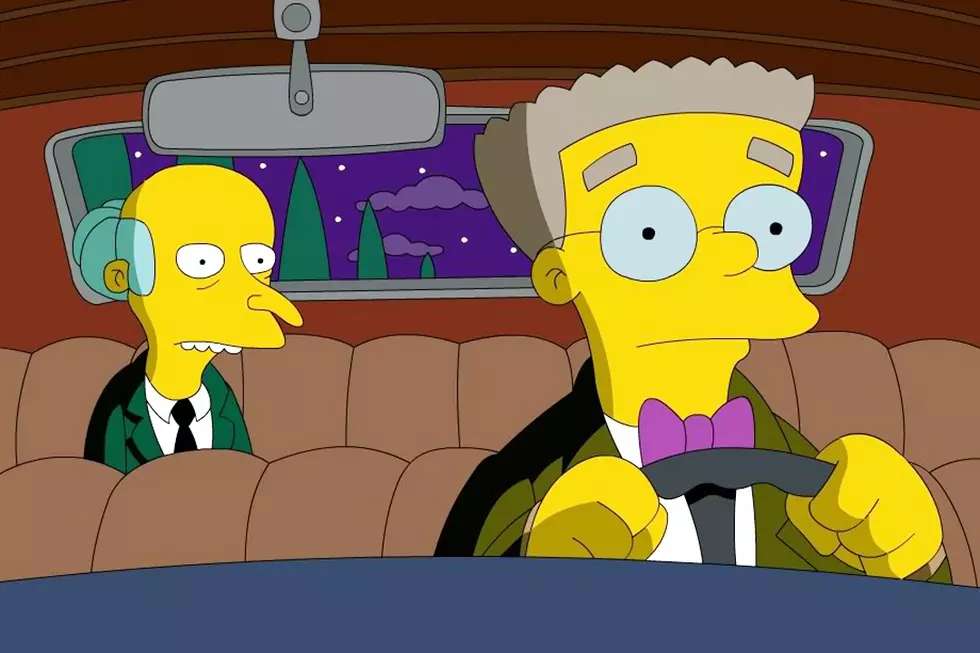
‘The Simpsons’ Marathon and Our Ongoing Pan-and-Scan Nightmare
'The Simpsons' marathon continues for its sixth straight day on FXX today amidst a growing chorus of complaints about the network’s decision to alter the format of every episode from the show’s first nineteen seasons. As detailed in Max O’Connell’s recent article on Indiewire, FXX has cropped and stretched pre-HD 'Simpsons' installments from their original 4:3 aspect ratio (the height and width of our old standard-definition TVs) to 16:9 (the dimensions of our new HD sets), apparently in order to make sure that no one suffers through old television episodes with black bars on the sides of the image.
The result has been a mess in which Homer, Marge, Bart, Lisa, Maggie and the rest of Springfield’s yellow-skinned denizens look squashed, smushed, and/or resized to the point of unnatural distortion. As a casual glimpse at almost any old Simpsons episode on FXX makes clear – including, alas, 'Das Bus,' still unrivaled for its out-of-left-field nastiness toward Arby’s – this process creates an image that’s at once unreasonably zoomed in, as well as cut off at the edges, so that the tops and bottoms of characters are missing, and background signs and text are only partially visible. It’s like watching the show via Facebook’s unwieldy profile-picture cropping mechanism.
This isn’t a unique phenomenon, but merely part and parcel of TV’s long-standing, distasteful and artistically blasphemous reconfiguration of both old and new material – a modern pan & scan crisis for our widescreen age. For years, pre-HD television programs have been awkwardly deformed to fit into a 16:9 box. Thus, revisiting fondly remembered moments from the likes of any classic small-screen comedy requires that one also ponder why, say, 'Seinfeld'’s Kramer – his frizzy hair severed at its peak – suddenly looks an awful lot like Ray Liotta having dinner in 'Hannibal.'
It’s a procedure driven by a belief that audiences, having fully committed to HDTV, want every inch of their LCD sets filled with content, and any attempt to saddle them with blank space on the screen’s sides will be met with objections. Regardless of any such (knuckleheaded) protests, however, pan-and-scanning is categorically wrongheaded, since its image alteration does nothing to add to the shows and movies upon which it’s performed – and, in most instances, does quite a lot to detract from them.
There are many perpetrators of this practice on TV, and the biggest is TBS, whose daytime schedule is dominated by reruns of 'The Fresh Prince of Bel-Air,' 'The King of Queens,' 'Friends' and 'Seinfeld' that have been warped from their original 4:3 to an ungainly 16:9. As the stills below confirm, there’s absolutely no benefit to this method, which makes 'Seinfeld' look too-close-for-comfort cramped while also negating parts of the image that were intended to be seen.
It is, fundamentally, a hack-job that discards the formal intentions of the show’s creators so that TV stations can make sure they avoid any potential complaints from customers who apparently can’t grasp why pre-HDTV should be shown in pre-HDTV formats. Not to mention that, without fail, it results in a picture that’s far uglier than the original.
To be fair, traditional sitcoms aren’t known for their aesthetic splendor, so no matter the unsightliness of these reformatted 'King of Queens' and 'Friends' episodes, the damage in these instances is relatively minor. However, they’re merely part of a far larger 16:9 pan-and-scan process that extends not only to old boxy material that won’t fit new HDTVs, but also to any movie – from any era – that’s been shot in a format other than 1.78:1 or 1.85:1 (both of which come very close to properly filling out a regular 16:9 HDTV). In other words, movies that were created in screen ratios either wider than a 16:9 image (most commonly, 2.35:1 or 2.40:1) or squarer than a 16:9 image (usually, 4:3) are now often artificially reconfigured to fill out an HDTV without the use of black bars. This occurs on just about every TV station that shows movies, from HBO, Cinemax and Showtime to TNT, FX and Comedy Central. And it also takes place on Netflix, and through cable companies and satellite providers’ pay-per-view and on-demand functions. To watch an HD movie that was shot in 2.35:1 via any of those channels or services now means that, more likely than not, you have to accept an inferior rearranged version of it.
In some cases, the loss of visual information may be minimal. And in other cases, as with 'Fight Club' on HBO, you actually get more image than you did in the theater, because David Fincher’s film was shown theatrically in 2.35:1 but shot in an “open-matte” format that, when unmasked and “opened up” to a 1.85:1 ratio, provides additional material on the top and bottom of the screen. Even in those instances, however, what you’re seeing on HDTV is definitely NOT what the filmmaker ideally intended. Rather, it’s a different version than the one the director signed off on, and has been changed by studio and TV personnel who have no creative relationship to the programs in question. The result is that movies which have been composed to fill out 2.35:1 dimensions (or greater) become visually unbalanced in 16:9 – enduring 'The Good, The Bad and the Ugly'’s finale in cropped HD entirely eliminates at least one character from the screen, and suffering through 'The Counselor' on HBO is to lose large swaths of imagery. They’re robbed of the very aesthetic elegance their makers sought.
Fortunately, DVDs and Blu-rays (and some online venues, like iTunes) still primarily preserve films and TV shows’ original aspect ratios – and, as evidenced by a flap over the Blu-ray release of 'Star Trek: The Next Generation,' they do so both because they value an artist’s intentions, and because pan-and-scanning for 16:9 screens leads to unacceptable hideousness. Moreover, a handful of admirable cable channels do remain staunch opponents of altering content, such as Turner Classic Movies and HDNet Movies. Yet the fact remains that people are now increasingly apt to find themselves watching 'The Simpsons' on FXX, or 'The Fresh Prince of Bel-Air' on TBS, or 'Jack Reacher' on Netflix, or 'The Counselor' on HBO, or 'Rush' on Cinemax, or 'Oz the Great and Powerful' on Starz, in out-and-out bastardized forms.
Ultimately, this problem is born from a lack of respect for both artists and audiences, and one that can only be changed by informed viewers voicing their disapproval. For everyone’s sake, let’s hope those cries of dissent begin ringing out soon, because from the looks of TV’s future – namely, 4k ultra-HD TVs, which sport a skinny 21:9 aspect ratio that will require all 4:3 and current 16:9 material to be cropped to fit its super-wide dimensions – we’re otherwise in for many more future pan-and-scan horrors.
Nick Schager has written for The Village Voice, Esquire, The AV Club and The Dissolve. You can contact him directly on Twitter.[googleAd adunit="cutout-placeholder" placeholder="cutout-placeholder"]
More From Rock 108










